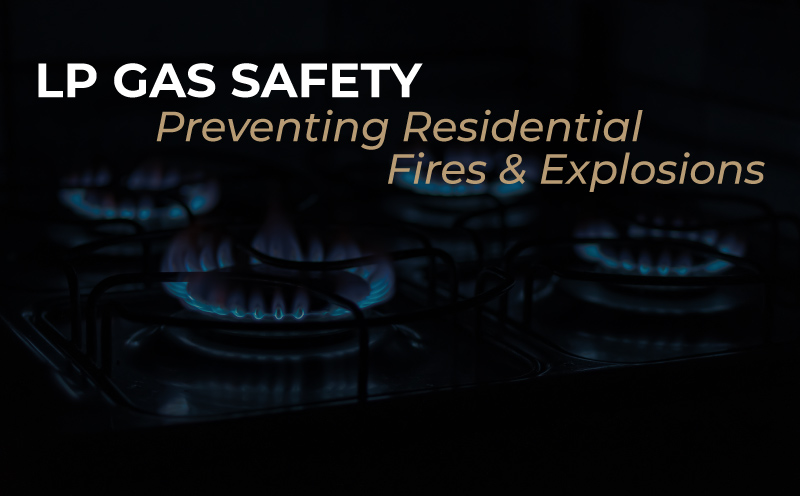LP Gas Safety – Preventing Residential Fires and Explosions

As a Kalamazoo personal injury attorney of over 35 years, I have represented many individuals and families who have suffered serious and catastrophic burn injuries as the result of LP gas system leaks. In virtually every case, a lack of application of basic and required safety rules caused these fires and explosions. Most commonly, these instances are the result of either the desire to cut corners or a lack of training and awareness of LP gas safety rules. Better education of homeowners and improved training of those who deliver LP gas and service LP gas systems can reduce or eliminate most of these explosions and fires. And while the resulting injuries are usually permanent and life-changing, they are oftentimes avoidable.
What is LP Gas?
Propane is derived from crude oil and natural gas. It is odorless, colorless, and heavier than air. Residential and commercial propane is liquified – hence the term LP gas (liquified petroleum gas). Because it is heavier than air in its gaseous state, propane will collect at ground level and low-lying areas. In its common usage, propane gas is liquified using pressured to condense the gas for storage and use. LP gas has a boiling point beginning at -42° C, or -50°F. Because LP gas is odorless and colorless, a chemical called ethyl mercaptan is added to it so that a leak can be smelled by LP gas users.
LP gas is highly flammable. It has a relatively narrow range for its lower and upper explosive limits (LEL and UEL). The LEL is 2.1 and the UEL is 9.5. What these numbers reference are the lower and upper concentrations with air, below and above which LP gas will not ignite. The LP gas that is stored in the common 500-gallon residential storage tanks is held under high pressure to maintain the propane as a liquid. In order to render the LP gas usable by the homeowner and to ensure LP gas safety, an LP gas delivery system was created.
Residential Gas Delivery System
The 500-gallon LP gas storage tank is located a safe distance from the home. As stated, LP gas in the tank is under high pressure and that pressure is too high for residential furnace and appliance use. To solve this problem, pressure regulators are installed in order to “step down” the pressure of the LP gas between the storage tank and the home.
The first stage regulator is located at the storage tank. This regulator steps the pressure of the LP gas inside the storage tank down to 10 PSI (pounds per square inch). The LP gas at 10 PSI then travels through a buried copper gas line toward the home. A second stage regulator is located outside of the home. This regulator steps the LP gas pressure down further, usually to 10 to 11 inches of water column. Water column is a unit of measurement. A device called a water manometer monitors the water column. At 11 inches of water column, the pressure of the LP gas is now useable by residential appliances and furnaces. To understand the comparative pressures, 11 inches of water column is equal to 1/2 of 1 PSI.
Mandatory Safety Rules – Gas Delivery and Maintenance of Residential Gas Delivery Systems
Michigan has adopted as law the National Fire Protection Association (NFPA) safety codes concerning LP gas. Michigan has also enacted a Residential Code, Section G2417.6.3, which reinforces the NFPA codes concerning the delivery of LP gas and maintenance of residential LP gas delivery systems. These codes address the most common causes and risks of leaks and explosions in residential LP gas delivery systems.
NFPA 58 Chapter 6 and NFPA 54 Chapter 8, as well as the Michigan Residential Code Section G2417.6.3 require that before an LP gas system can be placed back into service after any interruption of the service, an approved leak test must be performed. In addition, a new LP gas system must be both pressure-tested and leak-tested. NFPA 58 Annex L sets forth accepted methods of leak testing. Michigan Residential Code Section G2417.6.3 also requires the LP gas system be purged of air in accordance with G2147.7 and that the connections to the LP gas appliances and furnace must also be checked for leaks after any interruption of service.
Service interruptions occur whenever the residential LP gas system is “offline” for any period of time. This usually occurs when the customer reports that they are out of gas (e.g. the amount of gas in the outside storage tank is so low that service cannot be maintained) or when the system is shut down for maintenance or one type or another.
The instance of home explosions and fires tend to result either from the failure to cap recently unused LP gas supply piping (e.g. removing an appliance and failing to cap the LP gas line that had been supplying LP gas to the appliance) or a failure made by the employee of the company supplying LP gas or conducting maintenance of the LP gas system to conduct a leak test before placing the system back into service after an interruption of service.
Pressure Testing and Leak Testing Ensure LP Gas Safety
Not all LP gas company employees receive the stringent level of training required to properly conduct a leak test. Some employees confuse a pressure test with a leak test. A pressure test’s purpose is to ascertain whether the first and second stage regulators hold pressure at 10 PSI and 11 inches of water column, respectively. Importantly, when doing a pressure test, the main valve on the storage tank remains open, allowing for the maintenance of a working pressure at both the first and second stage regulators in order to test their functionality.
A leak test is performed at the second stage regulator by bringing or keeping the system at working pressure. The main valve at the tank is then closed all the way. A water manometer is then used to monitor the LP gas pressure and the second stage regulator for at least 10 minutes. This will measure whether the system from the second stage regulator holds steady pressure. If it does not, there is a leak.
If a leak lowers the pressure inside the home, and first stage regulator will call for the release of more LP gas from the storage tank to maintain pressure at 11 inches of water column. Therefore, conducting a pressure test only will not indicate or demonstrate a leaking system. The main storage tank and first stage regulator don’t “know” whether the pressure is dropping because an LP gas appliance turned on and increased the demand for LP gas or whether there is a leak in the system. Thus, performing a pressure test when a leak test is required will create a false conclusion that no leaks exist.
Within the LP gas industry, far too many employees who deliver and dispense LP gas to residential customers have not been adequately trained or supervised and often confuse which test is required despite the NFPA’s strict standards and specific provisions setting forth minimum training requirements which have been adopted into law in Michigan.
How to Protect Yourself and Ensure LP Gas Safety in Your Home
Homeowners can take several steps to minimize the risk of failure to test LP gas systems or improper testing, including:
-

Author Steve Weston
Familiarize yourself with these tests. Understand what pressure testing and leak testing are and the differences between the two.
- Be present during tank refills or returning service to LP gas systems after any interruption. By watching what’s going on, you can ensure both tests are conducted properly.
- Insist the service person conducts a leak test, watch what they do, and ask questions.
- Ask for the readings from the measuring equipment and an accurate recording of this measurement.
- Ask for confirmation of testing.
- Be aware of the smell of ethyl mercaptan additive (smells like rotten eggs). If you smell this odor, you likely have a gas leak.
- Leave your home and call either the fire department or the utility. Remember that opening doors or windows may not be safe to do, depending on how much LP gas has accumulated in the home and where it has accumulated. Remember the range between LEL and UEL is relatively narrow. Depending on the concentration, adding air may create a concentration within the UEL and actually result in an explosion.
- Be sure not to turn on or off any light, appliance, or otherwise introduce a competent ignition source that could spark and ignite the LP gas/air mixture.
While not all residential LP gas explosions can be avoided, the incidence can be significantly reduced when mandatory LP gas safety rules are properly observed.
Authored by: Steve Weston
Kalamazoo personal injury attorney and Michigan burn injury lawyer

